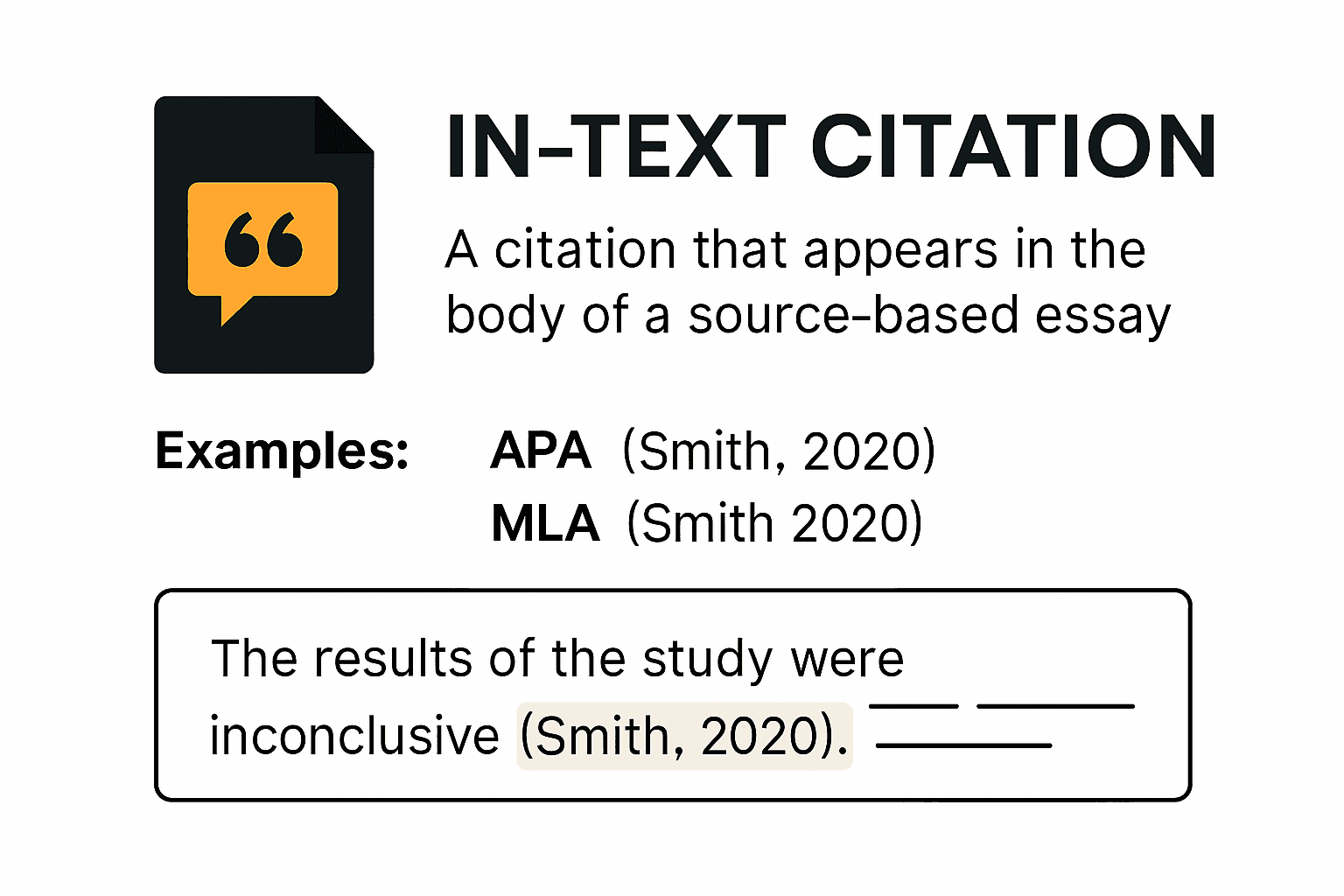Blog
Learning Materials
Ejemplo de ensayo con citas en el texto: Guía para 2025
Updated: June 28, 2025

Escribir un ensayo con citas en el texto es una habilidad que todo estudiante necesita, pero que incluso los escritores más experimentados encuentran desafiante. Sorprendentemente, las citas incorrectas representan hasta el 40 por ciento de los casos de plagio no intencional en ensayos universitarios. La mayoría de las personas piensa que citar se trata solo de colocar nombres de autores y fechas entre paréntesis. Aquí está la verdadera diferencia: saber cuándo, cómo y por qué citar no solo te protege del plagio, sino que también demuestra tu comprensión y credibilidad ante tus lectores.
Tabla de Contenidos
- Ejemplos de Citas en el Texto en MLA
- Técnicas de Citas en el Texto en APA
- Eligiendo el Estilo de Cita Correcto
Resumen Rápido
| Conclusión | Explicación |
|---|---|
| Domina las Citas en el Texto | Las citas en el texto son esenciales para establecer credibilidad en la escritura académica e implican proporcionar referencias breves dentro del texto que se correlacionan con entradas bibliográficas completas en una lista de referencias. |
| Entiende los Estilos de Citas | Diferentes disciplinas académicas utilizan estilos de citas específicos como APA, MLA y Chicago, cada uno con reglas de formato distintas que deben seguirse para la precisión y consistencia en las citas. |
| Sigue un Proceso de Citas | Un enfoque sistemático para citar fuentes incluye identificar tipos de fuentes, localizar información clave, seleccionar el estilo apropiado, formatear las citas correctamente y verificar los detalles de referencia para prevenir errores. |
| Evita Riesgos de Plagio | Mantener la integridad académica requiere una cuidadosa citación para prevenir el plagio no intencional, incluyendo el crédito adecuado para ideas parafraseadas y asegurando el uso de un formato consistente a lo largo de tu trabajo. |
| Utiliza la Gestión Proactiva de Citas | Implementar estrategias como mantener notas detalladas, usar herramientas de gestión de citas y consultar guías de estilo puede ayudar a gestionar las citas de manera efectiva y asegurar rigor académico en la escritura. |
Entendiendo las Citas en el Texto en Ensayos
En la escritura académica, dominar las citas en el texto es crucial para establecer credibilidad y dar el crédito adecuado a las fuentes originales. Estas referencias breves dentro de tu ensayo proporcionan un contexto inmediato sobre de dónde proviene la información, permitiendo a los lectores rastrear y verificar tu investigación.
¿Qué Son las Citas en el Texto?
Las citas en el texto son referencias breves incrustadas directamente en el texto de tu ensayo que apuntan a una entrada bibliográfica completa en tu lista de referencias. Cumplen múltiples propósitos críticos en la escritura académica. Aprende más sobre los fundamentos de las citas para mejorar tus habilidades de escritura académica.
Según Pennsylvania State University Libraries, las citas en el texto generalmente incluyen información clave de identificación como el apellido del autor y el año de publicación. Estas citas ayudan a los lectores a entender rápidamente la fuente de información específica sin interrumpir el flujo de tu escritura.

Importancia de la Cita Correcta
Citar fuentes cumple varias funciones esenciales en la escritura académica. Primero, demuestra integridad académica al reconocer a los investigadores y pensadores originales que contribuyeron a tu comprensión. Según las directrices de citación de Columbia College, la cita correcta previene el plagio y muestra respeto por la propiedad intelectual.
En segundo lugar, las citas en el texto proporcionan un rastro de evidencia que respalda tus argumentos. Cuando referencias trabajos académicos, demuestras que tus afirmaciones están fundamentadas en investigaciones establecidas en lugar de ser meras opiniones personales. Investigación de University of South Carolina Libraries enfatiza que las citas ayudan a los lectores a evaluar la credibilidad y profundidad de tu trabajo académico.
Estilos de Citas y Sus Variaciones
Diferentes disciplinas académicas prefieren estilos de citas específicos, cada uno con requisitos de formato únicos. Los estilos más comunes incluyen APA (American Psychological Association), MLA (Modern Language Association) y Chicago. Por ejemplo, en el estilo APA, una cita típica en el texto podría verse como (Smith, 2022), mientras que el estilo MLA a menudo incluye números de página, como (Smith 45).
Entender los requisitos matizados de cada estilo de cita es crítico. Algunos estilos exigen diferentes enfoques para fuentes sin autores claros, múltiples autores o fuentes digitales. Siempre consulta la guía de estilo específica recomendada por tu institución o disciplina para asegurar la precisión.
Las citas efectivas en el texto son más que simples requisitos técnicos. Son un aspecto fundamental de la comunicación académica, demostrando tu capacidad para involucrarte críticamente con la investigación existente y contribuir de manera significativa al discurso académico. Al dominar estas habilidades, transformas tu escritura de un simple informe a una conversación académica sofisticada.
Guía Paso a Paso para Citar Fuentes Correctamente
Citar fuentes correctamente es una habilidad crítica que requiere precisión y atención al detalle. El proceso implica más que simplemente agregar una referencia; demanda entender los requisitos específicos de diferentes estilos de citas y mantener la integridad académica.
Identificando Información Citable
Antes de crear una cita en el texto, primero debes reconocer qué información requiere atribución. Explora técnicas de citación en investigación para fortalecer tus habilidades de escritura académica. Según las Guías de Estilo MLA, debes citar fuentes cuando:
- Citas directamente las palabras de otro autor
- Parafraseas las ideas de otro escritor
- Referencias hallazgos o datos de investigación específicos
- Tomas prestadas interpretaciones o argumentos únicos
No toda la información requiere cita. El conocimiento común o los hechos ampliamente aceptados no necesitan referencia. Sin embargo, cuando tengas dudas, siempre es más seguro citar tu fuente.
Proceso de Cita Paso a Paso
Crear citas precisas implica un enfoque sistemático. Investigación de Columbia College Libraries describe un método integral para la documentación adecuada de fuentes:
-
Identifica el Tipo de Fuente: Determina si estás citando un libro, artículo de revista, sitio web u otra fuente. Cada tipo tiene requisitos de cita específicos.
-
Localiza Información Clave: Encuentra el nombre del autor, la fecha de publicación y el número de página (si corresponde). Estos detalles son cruciales para crear una cita en el texto precisa.
-
Selecciona el Estilo de Cita Apropiado: Elige el estilo de cita requerido por tu institución: APA, MLA, Chicago u otros. Cada estilo tiene reglas de formato únicas.
-
Crea la Cita en el Texto: Formatea la cita según el estilo seleccionado. Para APA, esto generalmente significa (Autor, Año); para MLA, suele ser (Autor Número de Página).
-
Verifica la Entrada en la Lista de Referencias: Asegúrate de que cada cita en el texto corresponda a una referencia completa en tu bibliografía o página de obras citadas.
Desafíos Comunes de Citas
La escritura académica presenta varios desafíos al citar fuentes. Guías de Investigación Universitaria destacan errores comunes a evitar:
-
Múltiples Autores: Diferentes estilos de citas tienen reglas específicas para fuentes con múltiples autores. Algunos requieren listar todos los nombres, mientras que otros usan et al. después del primer autor.
-
Sin Autor Claro: Para fuentes sin un autor nombrado, usa el título o el nombre de la organización en tu cita.
-
Fuentes Electrónicas: Las fuentes digitales a menudo requieren información adicional como DOI o URL, dependiendo del estilo de cita.
Dominar las técnicas de citación requiere práctica. Siguiendo estos pasos sistemáticos y entendiendo los requisitos matizados de diferentes estilos de citas, puedes crear ensayos académicamente rigurosos y formateados profesionalmente que demuestren integridad intelectual y habilidades de investigación académica.
Ejemplo de Ensayo con Citas en el Texto: Formatos MLA y APA

Navegar por diferentes formatos de citas requiere precisión y comprensión. Mientras que los estilos MLA y APA comparten el objetivo fundamental de acreditar fuentes, difieren significativamente en sus requisitos específicos de formato y enfoques para las citas en el texto.
Ejemplos de Citas en el Texto en MLA
Explora técnicas detalladas de citación en MLA para refinar tus habilidades de escritura académica. Según el Purdue Online Writing Lab, el formato MLA utiliza un método de autor-página para las citas. Aquí hay ejemplos precisos:
Cita de Autor Único Cita: La escritura académica exige una atención meticulosa al detalle (Smith 45). Paráfrasis: La investigación moderna enfatiza la complejidad de la comunicación académica (Johnson 112-113).
Múltiples Autores Para obras con dos autores, lista ambos apellidos: (Garcia y Rodriguez 23). Para tres o más autores, usa el apellido del primer autor seguido de et al.: (Williams et al. 56).
Sin Autor Disponible Usa una versión abreviada del título entre comillas: (Tendencias Globales 87).
Técnicas de Citas en el Texto en APA
Investigación de Columbia College Libraries destaca las características únicas del estilo de cita APA. El formato APA sigue un método de autor-fecha con estas características clave:
Cita de Autor Único Cita: La investigación psicológica demuestra procesos cognitivos complejos (Thompson, 2022, p. 45). Paráfrasis: Los estudios contemporáneos exploran patrones de comportamiento intrincados (Rodriguez, 2021).
Múltiples Autores Para dos autores, usa y en el texto y & entre paréntesis: Rodriguez y Lee (2019) o (Rodriguez & Lee, 2019). Para tres a cinco autores, lista todos los nombres la primera vez, luego usa el primer autor et al. en citas posteriores: (Martinez, Johnson, Lee, & Garcia, 2020).
Fuentes Secundarias Al citar una fuente citada dentro de otra fuente, usa como se cita en: Según Johnson (2018, como se cita en Martinez, 2022), los enfoques innovadores transforman la investigación académica.
Eligiendo el Estilo de Cita Correcto
Guías de Investigación Universitaria recomiendan seleccionar un estilo de cita basado en tu disciplina académica:
- Humanidades y Artes Liberales: Usualmente utilizan MLA
- Ciencias Sociales: Prefieren el estilo APA
- Ciencias Naturales: A menudo utilizan Chicago o formatos específicos científicos
La selección depende de tu campo de estudio, los requisitos institucionales y las convenciones específicas de tu área de investigación. Siempre confirma el estilo preferido con tu instructor o guía de estilo del departamento.
Dominar estos formatos de citas requiere práctica y atención al detalle. Cada estilo sirve a un propósito único en la comunicación académica, proporcionando métodos claros y consistentes para reconocer contribuciones intelectuales y apoyar el discurso académico.
Consejos para Evitar Errores Comunes de Citas
Los errores de citación pueden socavar la credibilidad del trabajo académico, potencialmente llevando a acusaciones de plagio o un rendimiento académico reducido. Entender y evitar errores comunes es crucial para mantener la integridad académica y producir investigaciones de alta calidad.
Reconociendo Riesgos de Plagio
Aprende técnicas esenciales de citación en investigación para proteger tu reputación académica. Según el Centro de Escritura de St. Louis Community College, el plagio puede ocurrir incluso de manera no intencional cuando las fuentes no se acreditan adecuadamente. Los riesgos clave incluyen:
- Parafrasear sin Citar: Reescribir las ideas de otra persona con tus propias palabras sin reconocer la fuente original
- Información de Fuente Incompleta: No proporcionar detalles completos de referencia
- Formato de Citas Inconsistente: Mezclar estilos de citas dentro de un solo documento
Siempre pregúntate: ¿Sabría una persona razonable que esta información proviene de otra fuente? Si la respuesta es sí, necesitas citarla.
Manejando Escenarios Complejos de Citas
Investigación de Columbia College Libraries destaca varios desafíos de citación matizados que a menudo confunden a los estudiantes:
Fuentes Secundarias Al citar una fuente que encontraste dentro de otra fuente, usa el formato Autor (Año, como se cita en Otro Autor, Año). Por ejemplo: Johnson (2018, como se cita en Martinez, 2022) demuestra la complejidad de la investigación académica. Solo la fuente secundaria aparece en tu lista de referencias.
Múltiples Autores Sé preciso con las atribuciones de autores. Diferentes estilos de citas tienen reglas específicas:
- APA: Usa et al. para fuentes con tres o más autores
- MLA: Lista todos los autores para fuentes con tres o menos autores
Fuentes Digitales y en Línea Las fuentes en línea requieren atención adicional. Guías de Estilo APA recomiendan incluir:
- Identificador de Objeto Digital (DOI) cuando esté disponible
- URL para fuentes sin DOI
- Fecha de acceso para contenido en línea que cambia frecuentemente
Gestión Proactiva de Citas
Prevenir errores de citación requiere un enfoque sistemático:
- Mantén Notas Detalladas: Registra información completa de la fuente inmediatamente al investigar
- Usa Herramientas de Gestión de Citas: Aprovecha software como Zotero o EndNote para rastrear referencias
- Verifica las Referencias: Asegúrate de que cada cita en el texto coincida con una referencia completa en tu bibliografía
- Consulta Guías de Estilo: Revisa regularmente las guías específicas para tu estilo de cita requerido
Recuerda que la citación es más que un requisito técnico; es un aspecto fundamental de la comunicación académica. Las citas adecuadas demuestran integridad académica, dan crédito a los investigadores originales y permiten a los lectores verificar y explorar tus fuentes.
Al entender estos errores comunes e implementar un enfoque cuidadoso para la documentación de fuentes, puedes evitar errores de citación y producir trabajos académicamente rigurosos que cumplan con los más altos estándares de escritura académica.
Preguntas Frecuentes
¿Qué son las citas en el texto?
Las citas en el texto son referencias breves dentro de tu ensayo que apuntan a una entrada bibliográfica completa en tu lista de referencias. Generalmente incluyen el apellido del autor y el año de publicación, ayudando a los lectores a identificar la fuente de información específica.
¿Por qué es importante la cita correcta en la escritura académica?
La cita correcta demuestra integridad académica, ayuda a evitar el plagio y proporciona evidencia para tus argumentos. Reconoce a los autores originales de ideas e investigaciones que respaldan tu trabajo, estableciendo credibilidad con tus lectores.
¿Cuáles son los estilos de citas más comunes para ensayos?
Los estilos de citas más comunes incluyen APA (American Psychological Association), MLA (Modern Language Association) y el estilo Chicago. Cada estilo tiene sus propias pautas de formato para citas en el texto y listas de referencias, por lo que es importante usar el especificado por tu institución.
¿Cómo evito errores comunes de citas?
Para evitar errores de citas, mantén notas detalladas de tus fuentes, usa herramientas de gestión de citas, asegura consistencia en tu formato y verifica que cada cita en el texto coincida con la referencia completa en tu bibliografía. Consultar regularmente la guía de estilo relevante también puede ayudar a prevenir errores.
Elimina Errores de Citas y Toma el Control de Tus Ensayos
¿Estás estresado por perder citas en el texto o perder horas tratando de entender las reglas de MLA vs. APA? Si te preocupa el plagio no intencional, el formato inconsistente o luchas por mantener tu integridad académica intacta, no estás solo. Muchos estudiantes enfrentan estos mismos dolores de cabeza, especialmente al intentar dominar las técnicas de citación discutidas en tu última guía. ¿Qué pasaría si escribir trabajos con citas perfectas y contenido original se convirtiera en la parte más fácil de tu vida académica?

Deja de lado tus ansiedades sobre citas permitiendo que Samwell.ai maneje los detalles por ti. Experimenta herramientas avanzadas de IA que no solo generan ensayos con referencias MLA o APA impecables, sino que también aseguran que todo tu trabajo pase verificaciones de detección en tiempo real. Únete a más de un millón de estudiantes y profesionales que mejoran sus calificaciones y confianza cada día. ¿Listo para transformar tu escritura académica y nunca más estresarte por las citas? Comienza ahora en Samwell.ai y ve la diferencia por ti mismo.
Artículos Recomendados
- Guía 2025: Entendiendo Tipos de Citas en el Texto
- Guía de Citas en el Texto en MLA 8 para 2025: Ejemplos Claros
Generate essays with Samwell.ai
Whether you’re a publisher, professor, journalist, or student, let us tailor a plan just for you.Artículos más leídos

Su guía para triunfar en la redacción de un ensayo
Consejos de expertos para escribir un ensayo: desde formular una tesis hasta estructurar eficazmente su ensayo.

Consejos para escribir: Estrategias para dominar la escritura
Mejore su redacción de ensayos con consejos de expertos sobre análisis, creación de tesis y estructura impactante.

Cómo escribir un ensayo de reflexión crítica: Consejos de expertos
Consejos de expertos para escribir un ensayo de reflexión crítica. Aprende a estructurar, elegir temas y utilizar las pruebas de manera efectiva.

Cómo escribir un buen gancho: Una guía paso a paso
Domina el arte de crear un buen gancho con nuestra guía. Crea aperturas cautivadoras para una primera impresión memorable.
